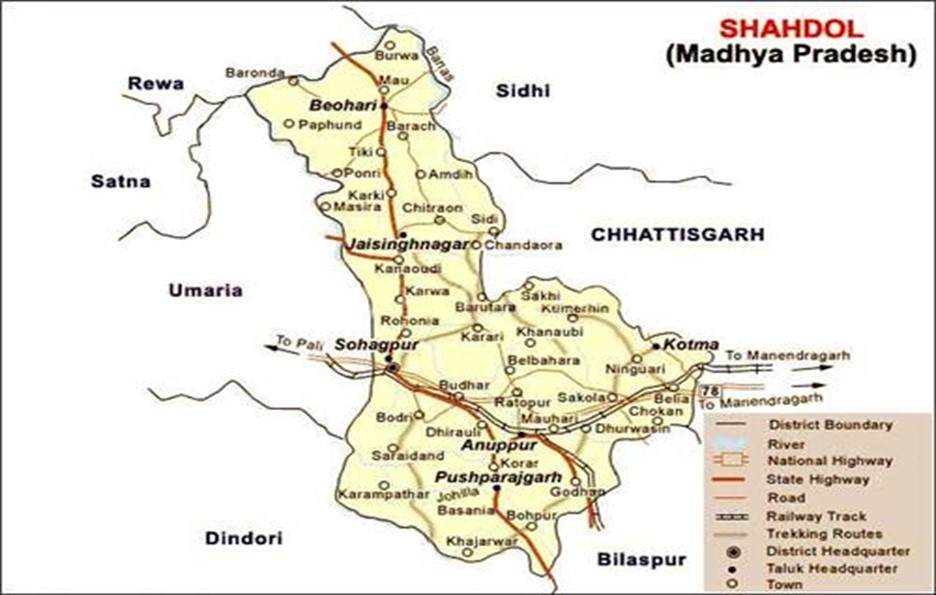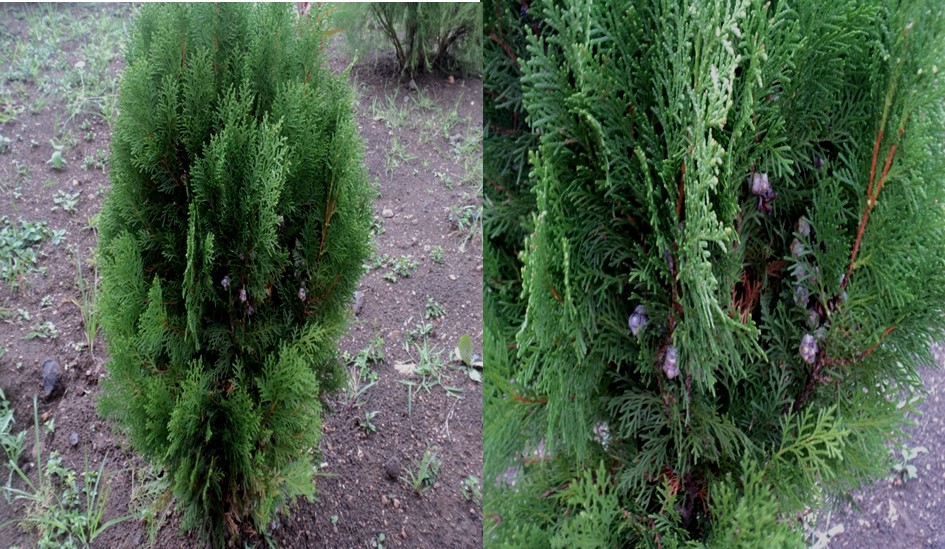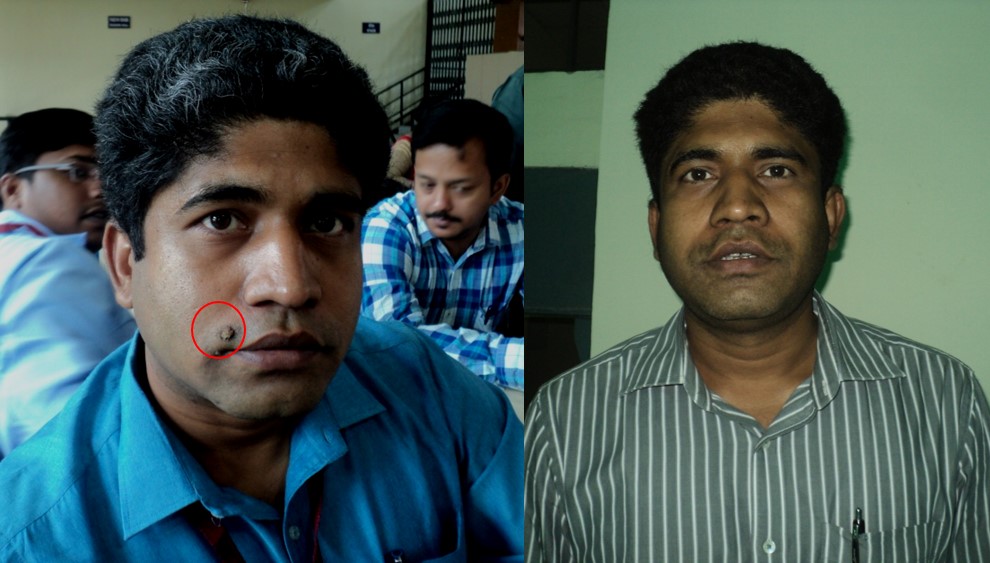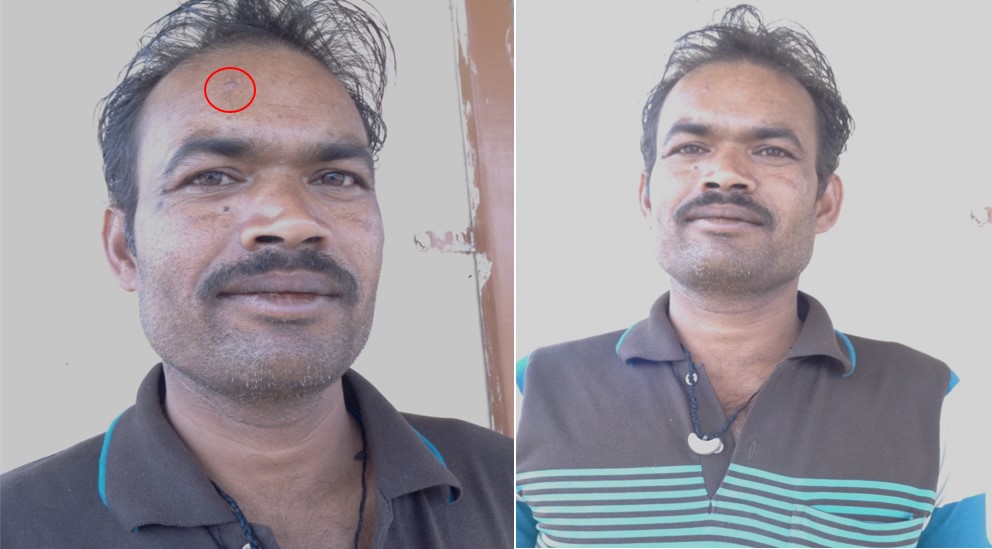Anti- Skin Wart Plant, “Thuja orientalis L.” Used By Tribals Of Shahdol District M.P. India
Author Name : Dr. Radhe Shyam Napit
Assistant Prof, Centre for Excellence, IGNTU Amarkantak (M. P.), India
Abstract
The present study carried out in Shahdol district, Madhya Pradesh led to documentation of one Plant species “Bidhya/ Mayur Phankhi” (Thuja orientalis L. syn T. biota L.) used as anti- Wart (Massa) medicines. The paper discloses details of botanical identity, local names, parts of the plant used, mode of preparation and administration of the drug and diseases for which the given plant is used.
Key Words – Anti-Skin Wart Plant, Thuja orientalis L., Used by Tribals, Shahdol District M.P., India.
Introduction
Shahdol district is prosperous in herbal wealth. The area is predominantly tribal and rural. People of this area usually practice agriculture for meeting their economic needs. Most of the population depends largely on plant resources growing in their surroundings to meet their requirements, including herbal therapy for sick men.
Ethnobotany is the study of the relationship which exists between people of primitive societies and their plant environment. The herbal remedies rely on the vast potential on protective and curative properties of plants. According to WHO, nearly 80% of the people in developing countries rely on herbal medication. Plants have been most fascinating objects of nature ever since. They have played a key role in health care needs of human beings.
Here we will discuss the utility of plant Thuja orientalis L., against the disease skin Wart. It is quality proved since time immemorial. Present study is based on the role of herbal treatment by medicinal plants for health care (conservation) as household occupation in Shahdol district, Madhya Pradesh. In this study, 1 plant/s arer identified and analyzed with their local name, Botanical name, Habit, Habitat, Medicinal use, Methods and Chemical constituents of utilization against diseases.
Ethnomedicinal plants need to be understood and planned for an understanding of indigenous knowledge and practices the most effective and efficient mechanism for conserving them is to prevent them from further destruction of habitats by us. Shahdol is a rich store house of many varieties of folk medicinal plants.
The total area of Shahdol district is 14028 Sq. Km. Total population of the district is about 10,66063 lakh (2011 Census). One will find Maikal Mountain range on its southern boundary while River Son flanks on its western with northern boundary. Its major part is covered with dense forest. The survey was conducted repeatedly from June 2013 – December 2014. In different seasons and areas detailed information was documented about plants, human diseases and recipes.


Fig.1-Shahdol District
Methodology
In this methodology, 15 villages were surveyed to observe the use of anti-diabetic plants by the local inhabitants. A very small number of tribals (about 09) were found to treat the wart (Massa) ailment persons by anti- wart plants. Majority of such persons were found illiterate while a few with primary or middle education practices to treat wart patients. Such persons treating wart (Massa) are usually called as medicine men. The quantity of plant parts used to treat wart was not standard. Other workers who studied plants were Jain (1991); Sarin (1996); Ghos and Das, (2000), Johnson,(1998); Ambasta, (1986); Sivarajan and Balachandran, (1994); Singh and Maheshwari, (1983); Warman, (1999); Warrier et al.,(1999).
Enumeration of Plant
Based on the information collected from the local inhabitants and tribal communities living in the area the enumeration has been done according the plant followed with botanical names, habit and habitat, distribution and mode of uses. They will not only lead to discovery of new medicinal plants, but also result in better understanding of the relationship between the local inhabitants. The benefit of indigenous knowledge can be harnessed and improved upon by its appropriate use, establishing validity of such knowledge and integrating it with health care program.
Description of Plant:
Distribution & Habit- Plant is native to China. A family (Cupressaceae) is an evergreen and monoecious tree or shrub, medium tree, 02-05 m tall. Stem- stringy- textured reddish-brown bark. The shoots are flat, with side shoots only in a single plane, branch lets. Leaves- The leaves are scale- like, except young seedlings in their first year, which have needle- like leaves., leaf lets its leaves in winter or not. Leaves are 0.8 in. (0.2 cm) long, bright yellow green when young, turning dark green with age. The leaves are scale-like (photo) and the foliage on branches is flattened into a pressed vertical plate. The leaves are arranged in flattened fan shaped groupings with resin-glands, and oppositely grouped in 4 ranks. The mature leaves are different from younger leaves, with those on larger branchlets having sharp, erect, free apices. Flowers are terminal and solitary. Fruit- Inconspicuous flowers develop into 1/2 to 1 inch long woody cones; fruit are globose-ovate and fleshy. Adaptation and Soil-oriental arborvitae has adapted to the eastern two-thirds of Kansas and is a tough tree that grows on a variety of soils and moisture conditions. Flowering- June – July, commonly occur in park/garden of Shahdol and all over India. Parts used: leaves.
The five species in the genus Thuja are small to large evergreen trees with flattened branchlets. Thuja orientalis has been used in the different activity that is, antipyretic, antitussive, astringent, diuretic, refrigerant and stomachic (Yeung, 1985).
Characters:- multi twigs whole or break shape, squama shaped leaves and mutual cross stand on the branches, flat shape connected each other, fresh leaves colored turquoise, turn into grey green to yellow green when stored some times, easily broken and aromatic, tastes bitter.


Fig-2 Thuja orientalis, Linn.)
Used
The paste of “Vidya /Mayur pankh” (Thuja orientalis, Linn.) leaf paste has local application (external use) once a day for 2-3 weeks to cure (remove) skin Warts.


Fig.3 Patient with Skin Warts.


Fig.4 Cured (Nil) Skin Warts.
Both Photographs are showing Wart diseases
Pharmacognostical studies
Pharmacognostical characteristic of Thuja orientalis, Linn including the macroscopically and microscopical feature of the green leaves have been reported.
Plant material- The leaves of Thuja orientalis (L.) Franco was collected manually from Pt. SNS Govt. Autonomous PG College Shahdol, M. P. in the month of June 2013 –Dec 2014. The plant material (1kg) was air dried at room temperature (30-40`C) and then powdered to pass through a sieve of 1mm and further subjected to various studies.
Chemicals and Reagents: All the chemicals and reagents used for the study were of analytical grade and procedures were adopted from official methods. Macroscopically characters; untreated sample was examined and studied for their macroscopical characters such as colour, odour, taste, shape, size and texture. The alignment of leaves was also observed. Microscopical characters; thin transverse sections of the leaves were cut using microtome (WES WOX Model, MT-1090 A) stained with 0.25% toluidine blue, adjusted to pH 4.7 and observed under compound microscope. Transverse sections of 10 to 12 µm thickness were prepared. Photography was done by using zeiss primo star trinocular microscope attached with canon photomicrograph unit.
Powder studies for microscopical examination; the powder was stained with phloroglucinol, concentrated hydrochloric acid and glycerine to study various anatomical features viz. sclerides, tracheids, unicellular trichomes, collenchyma, parenchyma and palisade cells.
Physicochemical parameters: The dried plant material was subjected for determination of physicochemical parameters. The ash values such as total ash, acid insoluble ash, water soluble ash and sulphated ash were determined according to standard procedures. The physicochemical parameters such as loss on drying, volatile oil content, extractive values, fluorescence analysis, foaming index, swelling index were determined according to official methods for quality control of medicinal plants.
Preliminary phytochemical screening: The preliminary phytochemical screening was carried out on the extracts obtained after successive extraction with petroleum ether, chloroform, ethanol and aqueous solvents. The dried extracts were treated with different chemical reagents for the detection of presence and absence of phyto constituents. Macroscopical characters- The leaves of Thuja orientalis was greenish when fresh and brownish in colour when dried. Young leaves were small needle shaped with slightly bitter taste and camphoreous odour. The texture was stringy and outer surface was rough. Alignment of the leaves was persistent scale like arranged in opposite decussate pairs. Microscopical characters- Transverse section of leaf showed single layered epidermis that was externally covered with a thick, striated cuticle. Beneath the epidermis single layered highly lignified thick walled hypodermis was present. Due to xerophytic nature, sunken stomata were seen in epidermal layer. Rows of elongated, closely arranged, palisade parenchyma followed by radically elongated spongy parenchyma cells with small intercellular spaces were present. The mesophyll is chlorenchymatous with varying number of plates like infolding of the wall projecting into cell cavity. The mesophyll is generally interspersed by resin ducts. The endodermis is a single continuous layer of barrel shaped cells. The transfusion tissue is composed of parenchymatous cells, resin and tracheids cell with bordered pits on their tangential and transverse walls. Single bicollateral vascular bundles were present in the central region.
Chemical Constituents
Thuja orientalis, Linn registered yields differed between organs; the greatest yield was obtained from needles followed by cones (1.1 and 1.21%, respectively). Chemical composition of the oils were specific to each organ, they even displayed the same chemo types. Thus, a total of 20–21 compounds accounting to 95.9–98.8% of the Biota essential oils were identified, respectively, in cones and needles. Both essential oils comprised mainly monoterpene hydrocarbons and displayed the same compounds but with quantitative differences. Among the identified components, α-pinene (64.2 and 49.3%, respectively, in cones and needles), β-phellandrene (6.7 and 9.6%), and α-cedrol (3.9 and 8.2%) were the most abundant. Myrcene, (Z)-caryophyllene and α-cedrene were also present in appreciable amounts. Monoterpene hydrocarbons, together with α-pinene, have been reported to be the major components of many species of the Cupressaceae family in particular B. orientalis, however, monoterpenic ketones have been reported to be the major components of many Thuja species. Species such as Thuja occidentalis and Thuja plicata, where the main monoterpenic ketone identified was α-thujone (50.1 and 62.1% respectively). The total ketone content in these oil samples varied between 54.3 and 69.1% (Tsiri et al. 2009). On the other hand, in our study B. orientalis oils and those from the same species cultivated in other countries were characterised by the abundance of monoterpene hydrocarbons (Nickavar et al. 2003; Magda et al. 2004). These differences are supported by other studies based on morphological traits and embryological characteristics that raised this specie to a new genus: Biota.
It may, therefore, be concluded that essential oil analysis can be of considerable help, providing basic information needed for the chemosystematic approach. In previous studies, Biota needle oils from Iran contained only 20.3% of α-pinene and a high level of δ-3-carene (14.2%). Nevertheless, the oils from Egypt contained 21.8% of α-pinene and a high level of benzyl benzoate (19.1%) and δ-3-carene (10.5%) while these components are minor or absent in the needle oil from our sample. Moreover, α and β-phellandrene are most abundant in our oils (14%) than the needle oil from Egypt (2.6%) and Iran (1.3%) (Nickavar et al. 2003; Guleria et al. 2008). Cone oils of B. orientalis were characterised Archives of Phytopathology and Plant Protection 21 by the very high content of α-pinene (64.2%) and other components which are present in appreciable amounts like α-cedrol (3.9%), β-phellandrene (6.7%), and myrcene (3%), which were also among the main components in the cone oils from B. orientalis originated in Iran and Egypt. Oxygen-containing monoterpenes and sesquiterpene hydrocarbons were present in low amounts.
Similarly, needle oil from Egypt was characterised by the abundance of monoterpene hydrocarbons (44.7%), and oxygenated sesquiterpene (25.9%). Differences found between the main constituents and subclasses of oils obtained from Tunisian B. orientalis and those from the same species but from other countries could be related particularly to climate, soils and genetic background of tree. Herbicidal effects of the essential oils of needles and cones of B. orientalis were tested on germination and seedling growth of Sinapis arvensis, L. rigidum and Phalaris paradoxa which are invasive weeds in cultivated areas. The results (Tables 2 and 3) show that both oils completely inhibited the emergence of these three weeds in comparison with the control. In general, a dose–response relationship was observed and the emergence declined with the increase in amount of Biota oil. At the doses of 1, 2 and 3 μl/mL, the germination of all tested weeds were reduced by both oils and totally inhibited at 4 μl/ml, while it only reduced the germination of L. rigidum. When germination was partially inhibited, velocity of germination is estimated by seed.
Chemical compositions of B. orientalis essential oils extracted from needles and cones. Compounds RIa RIb N(%) C(%) Identification α-pinene , RI MS ST Sabinene, RI MS β-pinene, MS Myrcene, RI MS ST α-phellandrene, RI MS δ-3-carene, RI MS β-phellandrene, RI MS δ-terpinene, RI MS α-terpinolene , RI MS α-terpinen, RI MS Bornyl acetate, RI MS Terpenyl acetate, RI MS α-cubebene, RI MS δ-elemene, RI MS ST (Z)-caryophyllene, RI MS α-cedrene, RI MS α-humulene, RI MS Germacrene D, RI MS β-selinene, RI MS α-murrolene, RI MS α-cedrol, RI MS Total identified (%): , Monoterpene hydrocarbons, Oxygenated monoterpenes, Sequiterpene hydrocarbons, Oxygenated sesquiterpenes, Note: RI: retention index, MS: mass spectrometry, ST: co-injection, –: not detected. a Apolar HP-5 MS column. b Polar HP Innowax column, N: needles, C: cones. 22 A. Ismail et al. vigour decreased under essential oil treatment. Moreover, not only emergence, even the seedling growth measured as root and shoot lengths was significantly reduced, the reduction was greater with increasing amount of Biota oil. At the germination stage, even cone essential oil contains more α-pinene, it was a little bit less effective than needle oils, but it is inverted at the seedling stage, particularly on the root growth.
Pharmacological studies
The immuno pharmacological potential of Thuja plant has been investigated in various in vitro and in vivo test models (33–35). Of the many existing studies on this subject, only the most relevant in vitro and in vivo investigations will be described in greater detail in the following one.
Antibody Production:-
The retentate fraction produced a concentration-dependent increase in the number of antibody-producing lymphocytes in the hemolytic plaque assay in vitro. The number of anti-SRBC-(sheep red blood cell)-IgM-producing plasma cells rose, as did all Ig-secreting plasma cells, as registered by the ‘reverse’ technique using protein A-labeled SRBCs. Incubation with lipopolysaccharide (LPS) as positive control also led to a concentration-dependent increase in the number of plaque-forming cells.[1]
Phytochemical analysis
The extracts of T. orientalis leaves was tested for the presence of various phytoconstituents such as carbohydrate, alkaloids, glycoside, phenolic compound and tannins, saponins, flavonoids, fixed oils and fat test. All phytochemical tests were done as per the procedure given in the standard book (Practical Pharmacognosy by C. K. Kokate).
Total phenolics:- Phenolics are most important plant constituents for their scavenging ability due to their hydroxyl groups. So, phenolic compound are directly involved for anti oxidative action. Total phenolic content was determined by Folin Ciocalteu method (Akhlaghi et al., 2011) with slight modification. Dried extracts (10 mg) was dissolved in 10 ml of 70% methanol. Extract solution (1000 μl) was added followed by 0.5 ml of 10% Folin Ciocalteu reagent and after 10 min were mixed with 0.4 ml of 7.5% aqueous sodium bicarbonate. Then the 1888 J. Med. Plants Res. mixtures were allowed to stand for 30 min and the amount of total phenols was determined by colorimetry at 730 nm using a spectrophotometer. The results are expressed as mg of Gallic acid equivalents/g of extract (GAEs).
Flavonoids:-
The quantity of total flavonoids content was determined using aluminum chloride colorimetric method with slight modifications (Quettier-Deleu et al., 2000). Dried extracts (10 mg) was dissolved in 10 ml of 70% methanol. Extract solution (1000 μl) was mixed with 1 ml of 2% aluminum chloride and 6 ml of 5% potassium acetate. Then, the mixtures were allowed to stand for incubation at room temperature for 40 min and the absorbance of the reaction mixture was measured at 415 nm versus the prepared blank using spectrophotometer. Total flavonoids were expressed in mg of quercetin equivalent per gram of the dry plant extract (mg QE/g).
Antioxidant activity determination by DPPH free radical scavenging assay:-
The free radical scavenging activity of plant extract was observed with stable 1, 1 diphenyl – 2- picryl hydrazyl radical (DPPH) (Braca et al., 2002). DPPH solution was prepared in solvent. The mixture was incubated for 20 min in the dark at room temperature. Test solution of plant extract (E1 and E2 extract) was prepared into two different concentrations (50 and 100 μg/ml). Free radical scavenging activity was determined spectrophotometrically by monitoring the decrease of the absorbance at 517 nm. Lower absorbance of the test sample indicates a higher free radical scavenging activity. Ascorbic acid was used as control and the blank reaction only containing the solvent which was used for the extraction. The percent DPPH radical scavenging activity was calculated in terms of percentage inhibition using the following equation: % inhibition = [100 × (Ac- As)] /Ac
Where Ac is the absorbance of the control and AS is the absorbance of sample. Tests were carried out in triplicate.
Minimum inhibitory concentration of extract:-
The minimum inhibitory concentration (MIC) value of extracts was determined by serial dilution method (Ibekwe et al., 2001; Sung et al., 2006). The extracts were diluted to make different concentrations. Serial dilutions of each extract were individually placed in tubes labelled 1 to 6. Tube-1 was filled with 2 ml of Muller Hinton broth including extract. 1 ml of extract from tube-1 was transferred to tube-2 and diluted with Muller Hinton broth. This procedure was repeated from tube-2 to tube-6 and each tube was filled with 1 ml Muller Hinton broth including bacterial suspension. The resulting mixture was incubated at 37± 0.1°C for 24 h. Turbidity was taken as an indication of growth and the lowest concentration which remained clear was recorded as the relative minimum inhibitory concentration. This test was repeated in triplicates. [2]
Clinical Studies
The first clinical trial (application) carried out on 09 patients (in the age group of 15-50 years) of mellitus, the leaf paste of (Thuja orientalis, Linn. syn T. biota L.).
Acknowledgement
The author is thankful to head of Department of Botany Dr. S.K.Mishra; Pt. S.N.S. Govt. PG. College Shahdol, Prof Dr. A. K. Shukla; dean faculty of B. Voc, Prof. Dr. N. K. Sharma and Dr. B. N. Tripathi HOD Deptt., of Biotechnology for their kind cooperation and also thankful to the tribal people of Shahdol District for completing the questionnaire, and articulate discussion pertaining to the skin disease wart (Massa) medicine (Ayurvedic Aushadhi).
References
- Agarwal, J.L., 2003., Defeating Diabetes. Reporter: 44-47.
- Akhlaghi M, Shabanian G, Rafieian- Koupaei M, Parvin N, Saadat M, Akhlaghi M (2011). Flor del Citrus aurantium y la Ansiedad Preoperatoria. Rev. Bras. 61(6):387-392.
- Ambasta, S.P., (Ed.) 1986., The Useful Plants of India. CSIR, New Delhi.
- Bhattacharjee, S.K., 1998., Hand Book of Medicinal Plants. Pointer Publisher, New Delhi.
- Anonymous, 1968., Medicinal Plants of india.Vol.1. ICMR, New Delhi.
- Ambasta, S. P. (ed.) 1986., The useful plants of India. CSIR, New Delhi.
- Bhalla, N.P.Sahu, T.R.Mishra, G.P. and Dakwale, R.N. 1982., traditional plant’s medicines of sugar, Distt., of Madhya Pradesh J. Econ. Taxon. Bot. 3:23-32.
- Binu, Nayar, T. S. R. & Pushpangadan, P., 1992., An outline of ehtnobotanical research in India. J.econ.taxon. Bot. (Addl.Ser.) 10:405-428.
- Braca A, Sortino C, Politi M, Morelli I, Mendez J (2002). Anti-oxidant activity of flavonoids from Licania licaniaeflora. J. Ethnopharmacol. 79: 379-381.
- Chopra, R.N., Chopra, I.C. and Verma, B.S. 1968., supplement to Glossary Indian Medicinal Plant’s. CISR, New Delhi.
- Das, A., 1976., Bitters and Diabetes. Indian Drugs. 14-168.
- Ibekwe VI, Nnanye NF, Akujobi CO (2001). Studies on antibacterial activity and phytochemical qualities of extracts of orange peels. Int. J. Environ. Health Hum. Dev. 1:41-46.
- Jain, S. K., 1963., Studies in Indian ethnobotany Plants used in medicine by tribals of Madhya Pradesh Bull. Reg. res. Lab. Jammu. 1126-128.
- Jain, S.K., 1964., Native Plant remedies for snake bite along Adivasis of central India. Indian Med. J.57:307-369.
- Jain, S. K. 1968., Medicinal Plant, National Book Trust, New Delhi.
- Jain, S. K., 1965., Medicinal Plant Lore of Tribal’s of Baster Econ. Bot. 19:236-250.
- Jain, S. K., 1961., Dictionary of Indian Folk Medicine and Ethnobotany, Deep Publication, New Delhi.
- Jain, S.K., (Ed.) 1987., A manual of Ethnobotany. Scientific Publishers, Jodhpur.
- Kapale, R., Prajapati, A. K., Napit R. S. & Ahairwar, R. K. 2013., Traditional Food Plants of Baiga Tribal`s : A Survey Study in Tribal Village of Amarkantak–Achanakmar Biosphere, Central India. (2):27-30.Ind. J. Sci. And Tech. 2013.
- Kumar, Ramesh; et al.: Traditional Use of Plants of Amarkantak; Indian Journal of Traditional Knowledge Vol. 3(4) October 2004.pp. 383-390.
- Maheshwari, P. & Singh, W. 1965.Dictionary of Economic Plants in India. I. C. A. R. New Delhi.
- Maheshwari, J.K., 1970., New vistas in ethnobotany. J. econ. Taxon Bot. (Addl.ser): 1-11.
- Napit, R. S., and Kumar K. 2012., Ethnomedicinal use Euphorbia Plants by Tribal Communities of Shahdol District of M. P. Agrobios News Letter Page. N0. 47-48.
- Napit, R. S., Shrivastava D. K. & Mishra S. K. 2011., Ethno-medico Botanical Study of Paliha Tribe of Gohparu Block Distt. Shahdol M. P. (India) Journal of Tropical Forestry Vol. 27. Pag N0. 62-64.
- Napit, Dr. Radheshyam, 2015., Ethnomedicinal Studies on Baiga Tribes in Jaisinghnagar Block District Shahdol M.P. Central India. Research Hunt An International Multi Disciplinary e-journal, Vol.χ Issue. I, Jan-Feb -2015 Pag. 9- 12.
- Napit, Dr. Radheshyam, 2015., Medicinal Plant King of Bitters “Swertia chirata Buch.Ham.” (Gentianaceae) Chirayata Used by Tribals of Amarkantak regions District Anuppur Central India. Research Hunt An International Multi Disciplinary e-journal,. Vol.χ Issue. I Jan-Feb -2015 Pag.1-4.
- Napit, Dr. Radheshyam, 2015., Ethnomedicinal Plants (Ptreridophytes) Study and Indegenous Knowledge of Pushprajgrah block with Special Reference to Amarkantak Anuppur District M.P. India. Research Hunt An International Multi Disciplinary e-journal, Vol.χ Issue. I Jan-Feb -2015 Pag.5-8.
- Napit, Dr. Radheshyam, 2015., Calotrapis (Asclepiadaceae) Plants Used By The Tribal And Local Peoples. In The Administered Of Skin Disease “Leucoderma” District Shahdol Central India. Naveen Shodh Sansar (An International Refereed Research Journal) Jan. to March Vol.1 Pag.34-35.
- Napit, Dr. Radheshyam. 2016., Anti- Diabetic Plant Pterocarpus Marsupium Roxb. Used By Tribals Of Shahdol District M.P. INDIA. Vol-2, Issue-10, 2016.Page No. 194-197. IJIR.
- Napit, Dr. Radheshyam. 2016., Traditional Knowledge of Plant “Tinospora cordifolia” Used by Local People in Loss of Blood Platelets of Shahdol Central India. Vol-2, Issue-10, 2016. Page No.198-202. IJIR.
- Quettier-Deleu C, Gressier B, Vasseur J, Dine T, Brunet C, Luyckx M, cazin M, Cazin JC, Bailleul F, Trotin F (2000). Phenolic compounds and antioxidant activities of buckwheat (Fagopyrum esculentum Moench) hulls and flour. J. Ethnopharm. 72:35-42.
- Ramachand, N.C. 1981., Ethnobotanical ran, V.S. and Nair observation on rurals of Tamil Naidu (India). J.Econ. Taxon. Bot. 2:183-190.
- Sinha, A., 1959 a, Chemical examination of the seeds of Jatropha curcas Linn. J. Inst. Chem. (India) 31, 213.
- Sinha, B. K. and Dixit, R.P. 2001., Ethnobotanical studies on Sarcostemma acidum (Asclepiadacea) from Khargaon Distt. Madhya Pradesh Ethnobotany 13:116-117.
- Shah, N.C.1994a., Ethnobotany of some well-known Himalayan Composites: Biology & Utilization. Proceedings of the International Composite Conference Eds. PDS Caligan & DJN Hind. (D.J.N. Hind, Editor-in-Chief). Kew: Royal Botanic.
- Shah, N. C., 1987., Ethnobotany in the Mountainous Region of Kumaon Himalaya. Thesis Submitted to the Kumaon University, Nainital for the Degree of Doctor of Philosophy in Botany. 1-255.
- Yeung HM (1985). Handbook of Chinese herbs and formulas. Institute of Chinese Medicine. Los Angeles, C.A.
=====0=====
[1] Literature source- http://www.ncbi.nlm.nih.gov/pmc/articles/PMC1062158/
[2] Literature Source- http://www.academicjournals.org/JMPR Journal of Medicinal Plants Research

